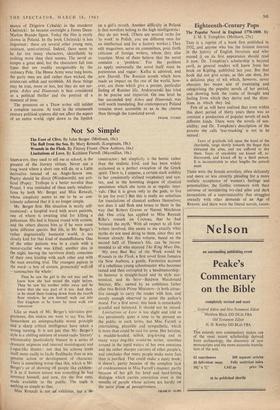Eighteenth-Century Pops
THIS is a reprint of a book first published in 1932, and anyone who has the faintest interest in the history of English literature and who missed it on its first appearance should read it now. Dr. Tompkins's scholarship is beyond cavil, as general readers will know from her book on Kipling, published last year. But that book did not give scope, as this one does, for a delicious play of wit which, however, never obscures her major aim of examining and categorising the popular novels of her period, and showing both the trains of thought and feeling from which they derive and the direc- tions in which they led.
Few of us will have realised that even within this short period of thirty years there was so constant a production of popular novels of such different kinds. There were the novels of sen- sibility; and Dr. Tompkins's description of the process she calls 'tear-tracking' is not to be missed: Tears of gratitude fall upon the hand of the charitable, verge slowly towards the finger that extracted the alms, and are suffered to dry there. Tears of sensibility are kissed off, re- discovered, and kissed off by a third person. It is inconceivable to what lengths the pursuit went.
There were the female novelists, often delicately and more or less covertly pleading for a more realistic acceptance of women's feelings and potentialities; the Gothic romances with their universe of mouldering ivy-clad piles and dark invocations of a supernaturality that struggled uneasily with other demands of an Age of Reason; and there were the liberal novels, vaunt-
ing the noble savage, the untutored intellect (Tarzan would seem a direct descendant of many of these), a genre that fell into cautious desuetude soon after the French Revolution broke out.
Reviewers, as Dr. Tompkins explains, were in somewhat the same dilemma as reviewers today (or perhaps in 1932) when confronted with de- tective novels. Critical standards had not yet been established. It was generally agreed that the function of the novel was a didactic one, the presentation of useful models of virtue, and didacticism as crass as in the worst modern children's books was often commended. But as the period progresses, we see increasing depth and development both in writers and in critics. Critics became better equipped to judge as writers to write. 'Gradually the novel—even the library novel—ceases to move within a tradi- tional world and opens to the world without.'
Among the most valuable offerings of this book is the light it throws on later and greater writers who, to an extent most of us had not realised, developed from and leant upon the traditions here described. Byron was not the first passionate hero, nor Scott the first historical novelist, though it still seems to remain true that for Jane Austen the earlier popular novels were rather part of the furniture of the world she observed than a necessary part of her own literary tradition.
Space forbids more than a hint of this book's many delights, but for a sample readers might like, in bookshop or library, to open it at p. 286, where they will find, in a footnote, a list of literary hermits. It seems a pity that in a book itself bibliographically immaculate the publishers should have omitted the date of this new im- pression.
MARGHANITA LASKI



































 Previous page
Previous page